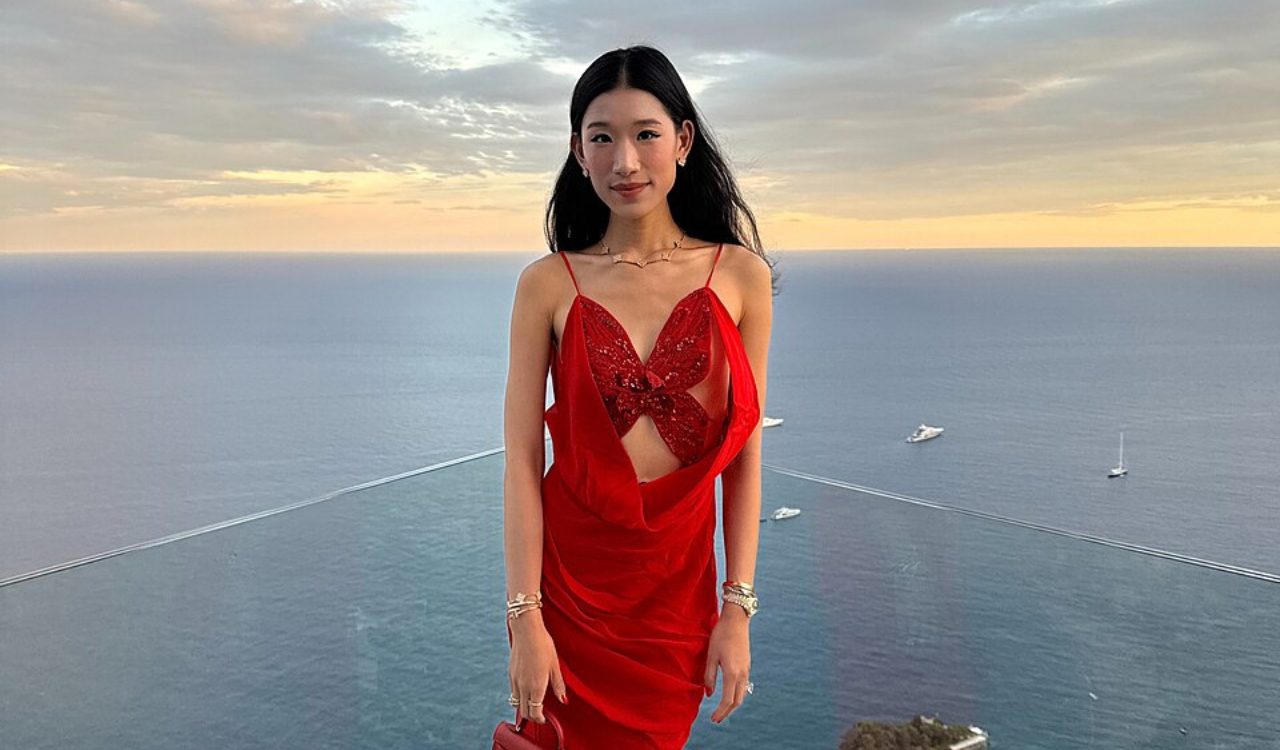“Becca Bloom” by Rubyzinner, licensed under Creative Commons Attribution-Share Alike 4.0 International license, via Wikimedia Commons.
Fashion designers aim to answer the question of “what does the world need right now?” Now it’s the social media universe that has answered this searing question in the form of the 27-year-old queen of #richtok, Becca Bloom. Critics say that Bloom’s lavish lifestyle and opulent wardrobe make her the “Marie Antoinette of the Digital Age.” Nonetheless, with 4.8 million followers on TikTok and 2.7 million on Instagram, Bloom is piquing Gen Z’s genuine interest in luxury brands.
Bloom’s social media feeds share access to topics normally relegated to the insider knowledge of the privileged few. In so doing, Bloom makes her lavish lifestyle feel motivational for her millions of followers.
Who Is Becca Bloom?
Becca Bloom, real name Rebecca Ma, is blowing up memes in a time where there’s contradictory discourse around nepotism in every field. Bloom grew up in Atherton, California, a small Bay Area town that also boasts the most expensive zip code in the country. Her parents met working at IBM in Silicon Valley and, together, they founded Camelot Information Systems, a China-based technology company.
Becca achieved her success skipping the rags-to-riches story and therein lies a lesson for luxury retailers. The fact that there’s nothing faux riche about Ma is a selling point for many of her followers who decry the in-your-face aesthetic common among luxury influencers on social media. Bloom’s followers appreciate that she wears luxury fashion like old money because she is the modern version of old money (granted, that’s old money, first-generation style). Modern, self-made wealth has a different persona in 2025: Becca’s day job in finance technology and the way she presents STEM and finance information to her followers set her apart as a luxury icon.
How is Bloom redefining fame and luxury for Gen Z, and why is her authenticity more important than relatability in the modern luxury landscape?
Quiet Luxury’s Replacement
Quiet luxury is officially over; consider Becca Bloom’s success its death rattle. Next gens don’t think about the aged faces of established fashion houses like Donatella Versace, Giorgio Armani or Karl Lagerfeld when they think of luxury. They’d be mortified by the logomania trend of the early 2010s. Performatively flaunting wealth feels toxic amid the uncertainties of today’s world and next gen’s obsession with authenticity. And the Succession-inspired quiet luxury movement that let logo-free designers like Bruno Cuccinelli and Tom Ford take center stage? Not in 2025. So, if next-gen luxury isn’t flaunting wealth or hiding it, what will replace quiet luxury?
A recent article in the Wall Street Journal shows Bloom assembling chef-prepared quail eggs on a Versace platter for her Scottish Fold cat named Oscar. So, it’s safe to surmise that keeping her wealth under wraps isn’t exactly a concern of Bloom’s. But the difference between Bloom and maximalist luxury influencers like Miiadio is that Bloom wears her wealth naturally. Bloom wears luxury like she was born in it because she was. Her take on luxury is not at all low-key, but it is creative, inspiring, and intentional.
Making Luxury “Relatable”
Bloom was born into her parents’ self-made wealth. That security net may have given her an added confidence boost to begin founding companies when she was still in high school: Studipal, a peer-to-peer tutoring platform, and Hearth Wireless Chargers. Her luxury lifestyle may not be relatable to most of her followers, but she gives them access to her lifestyle and the aesthetic discernment that comes with it. Bloom’s success is a lesson for luxury retailers trying to attract next gen spend; taste as an influencer can be monetized
But it’s not just the insider knowledge of how to dress with natural luxury style that attracts Bloom’s followers. Similar to how she gives her followers access to her aesthetic on social media, she also gives them the financial advice to, ostensibly, help them achieve wealth of their own. Her lifelong involvement in tech and finance gives her firsthand experience of the gatekeeping that occurs within both industries. Men as gatekeepers to STEM and finance is a “pet peeve” of Bloom’s, so she regularly shares STEM and finance advice with her 90 percent female following.
The juxtaposition of financial advice alongside images of Bloom on sailboats wearing Van Cleef and Arpels carries the implicit message, “this could be your life too, if you do as I do.” While this isn’t going to be true for most of her followers, not born into wealth, her message of hope through aesthetics and brass-tacks financial management makes her feel like a successful older sister who is ready to divulge how she built a beautiful life moving up in male-dominated industries. Who wouldn’t tune in for that?
Intentional Luxury without the “Cringe” Factor
Bloom is selling luxury to Generation Z by sharing access. She does very few sponsored posts because she doesn’t have to, so there isn’t the cringe “add to cart” factor that we see with other luxury influencers. Bloom’s aesthetic is less about overt branding and more about confident quality, which feels refreshing in a time when the job market is uncertain and financial anxiety is at an all-time high. Bloom’s social media feeds share access to topics normally relegated to the insider knowledge of the privileged few. In so doing, Bloom makes her lavish lifestyle feel motivational for her millions of followers.
Bloom also dispels the notion that one needs a rags-to-riches story to be celebrated as modern success. Speaking authentically about her privileged upbringing and, more importantly, sharing access to her financial, STEM-focused, and aesthetic knowledge makes Bloom feel authentic even when she’s wearing $10,000 shoes. Her success proves that quiet luxury and maximalism are two sides of an outdated coin: Curation, access, and authenticity drive today’s luxury market.





